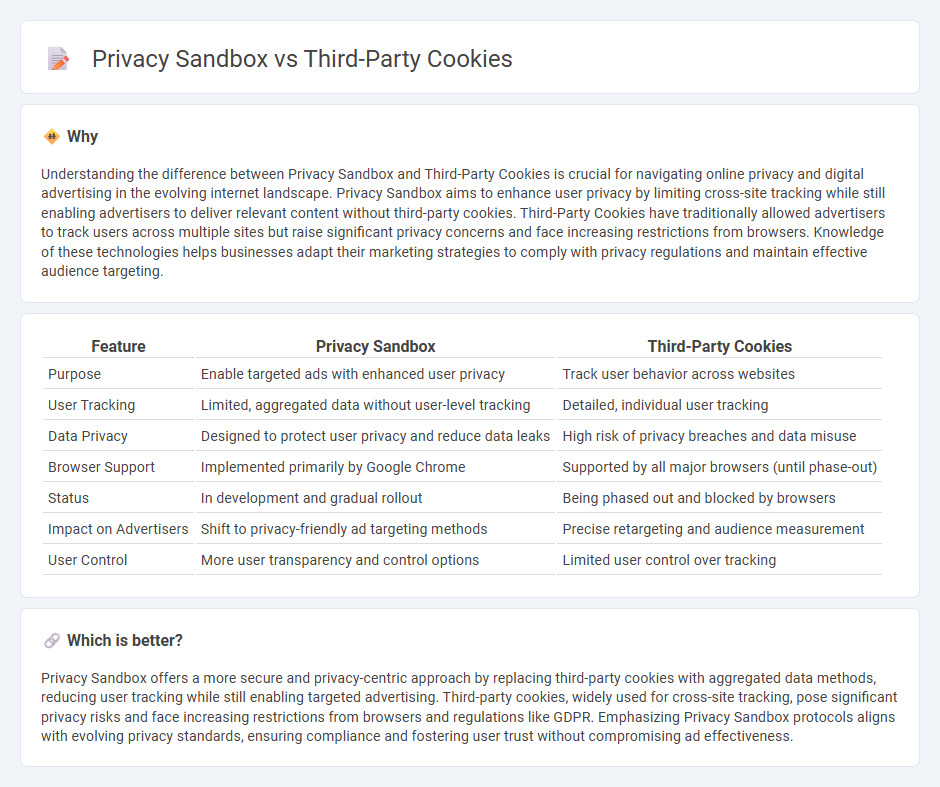
Privacy Sandbox represents Google's initiative to enhance user privacy by limiting third-party cookie usage, focusing on anonymized data and consent-based tracking methods. Third-party cookies enable cross-site tracking but pose significant privacy risks, leading to widespread browser restrictions and regulatory scrutiny. Explore the evolving landscape of digital tracking to understand the future of online privacy and advertising.
Why it is important
Understanding the difference between Privacy Sandbox and Third-Party Cookies is crucial for navigating online privacy and digital advertising in the evolving internet landscape. Privacy Sandbox aims to enhance user privacy by limiting cross-site tracking while still enabling advertisers to deliver relevant content without third-party cookies. Third-Party Cookies have traditionally allowed advertisers to track users across multiple sites but raise significant privacy concerns and face increasing restrictions from browsers. Knowledge of these technologies helps businesses adapt their marketing strategies to comply with privacy regulations and maintain effective audience targeting.
Comparison Table
| Feature | Privacy Sandbox | Third-Party Cookies |
|---|---|---|
| Purpose | Enable targeted ads with enhanced user privacy | Track user behavior across websites |
| User Tracking | Limited, aggregated data without user-level tracking | Detailed, individual user tracking |
| Data Privacy | Designed to protect user privacy and reduce data leaks | High risk of privacy breaches and data misuse |
| Browser Support | Implemented primarily by Google Chrome | Supported by all major browsers (until phase-out) |
| Status | In development and gradual rollout | Being phased out and blocked by browsers |
| Impact on Advertisers | Shift to privacy-friendly ad targeting methods | Precise retargeting and audience measurement |
| User Control | More user transparency and control options | Limited user control over tracking |
Which is better?
Privacy Sandbox offers a more secure and privacy-centric approach by replacing third-party cookies with aggregated data methods, reducing user tracking while still enabling targeted advertising. Third-party cookies, widely used for cross-site tracking, pose significant privacy risks and face increasing restrictions from browsers and regulations like GDPR. Emphasizing Privacy Sandbox protocols aligns with evolving privacy standards, ensuring compliance and fostering user trust without compromising ad effectiveness.
Connection
Privacy Sandbox is Google's initiative designed to phase out third-party cookies in Chrome while enabling advertisers to target ads effectively without compromising user privacy. Third-party cookies have traditionally tracked user behavior across websites, raising significant privacy concerns that Privacy Sandbox addresses through new APIs and privacy-preserving technologies. This shift aims to balance personalized advertising with enhanced user control over data in the evolving digital ecosystem.
Key Terms
Tracking
Third-party cookies have traditionally enabled advertisers to track user behavior across websites, raising significant privacy concerns due to extensive data collection without explicit user consent. The Privacy Sandbox, introduced by Google, aims to replace these cookies with privacy-preserving APIs that limit individual user tracking while enabling targeted advertising through aggregated and anonymized data. Explore how the Privacy Sandbox balances effective ad targeting with enhanced user privacy and compliance with evolving regulations.
FLoC (Federated Learning of Cohorts)
Third-party cookies track user data across websites, enabling targeted advertising but raising significant privacy concerns. Privacy Sandbox, introduced by Google, replaces these cookies with technologies like FLoC (Federated Learning of Cohorts), which clusters users into anonymous groups based on browsing behavior to limit individual tracking. Discover how FLoC balances ad relevance and user privacy by exploring its technical details and implications.
User Consent
Third-party cookies have traditionally enabled advertisers to track user behavior across websites, raising significant privacy concerns and prompting regulatory scrutiny. Google's Privacy Sandbox shifts the focus towards anonymized data aggregation and user consent mechanisms, aiming to balance targeted advertising with enhanced privacy protections. Explore the implications of this transition and the evolving standards for user consent in digital advertising.
Source and External Links
Third-party cookies - Privacy on the web - This webpage explains what third-party cookies are, the issues associated with them, and workarounds for those issues.
The end of third-party cookies: how to adapt your marketing strategy - This article discusses the implications of phasing out third-party cookies, their role in advertising, and strategies for adapting marketing strategies.
What is a third-party cookie? - This webpage defines third-party cookies, explaining how they are used for tracking user activities across multiple websites, primarily for personalized advertising.
 dowidth.com
dowidth.com